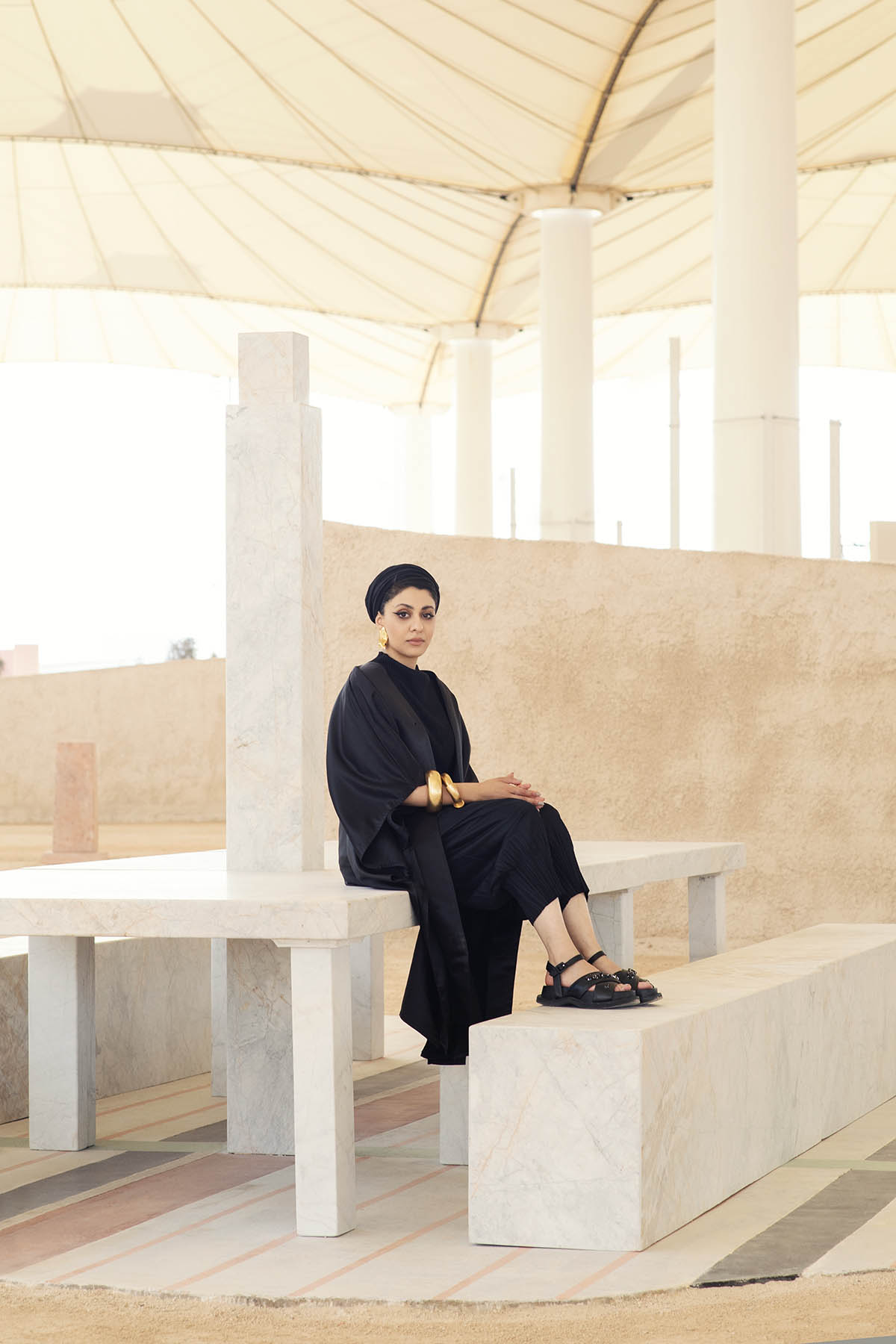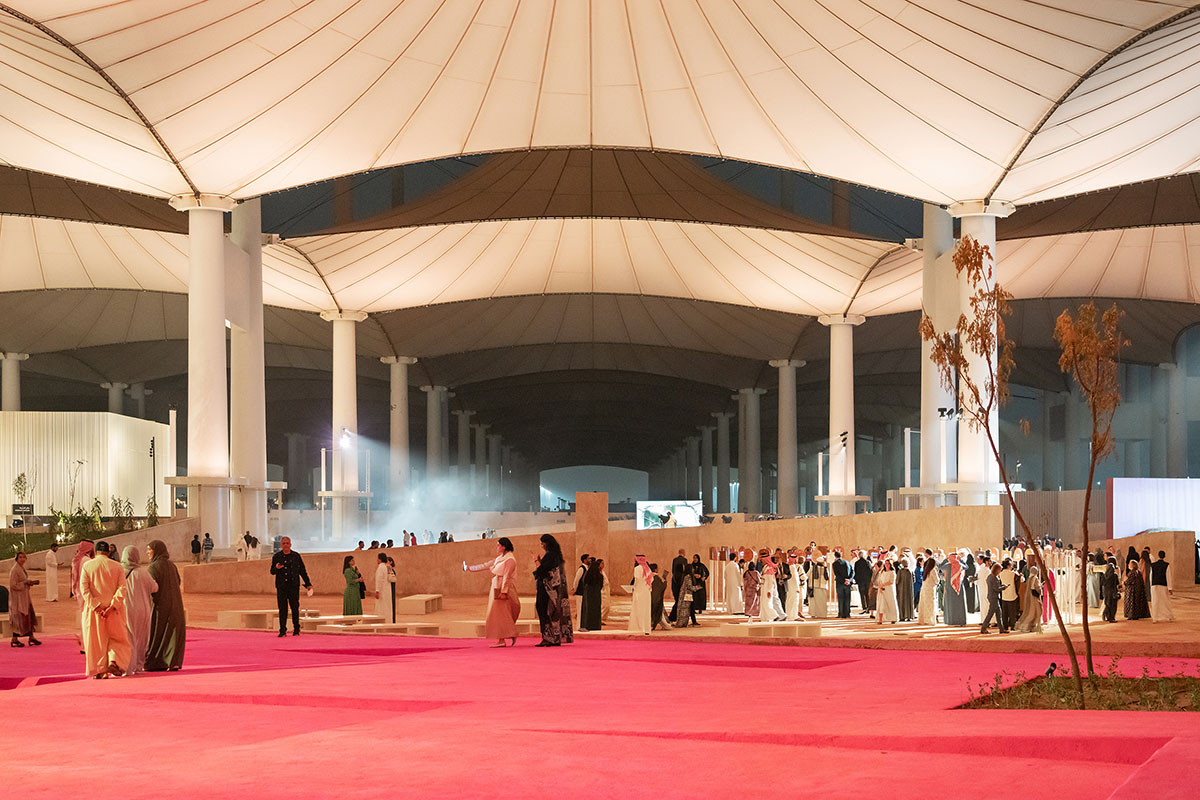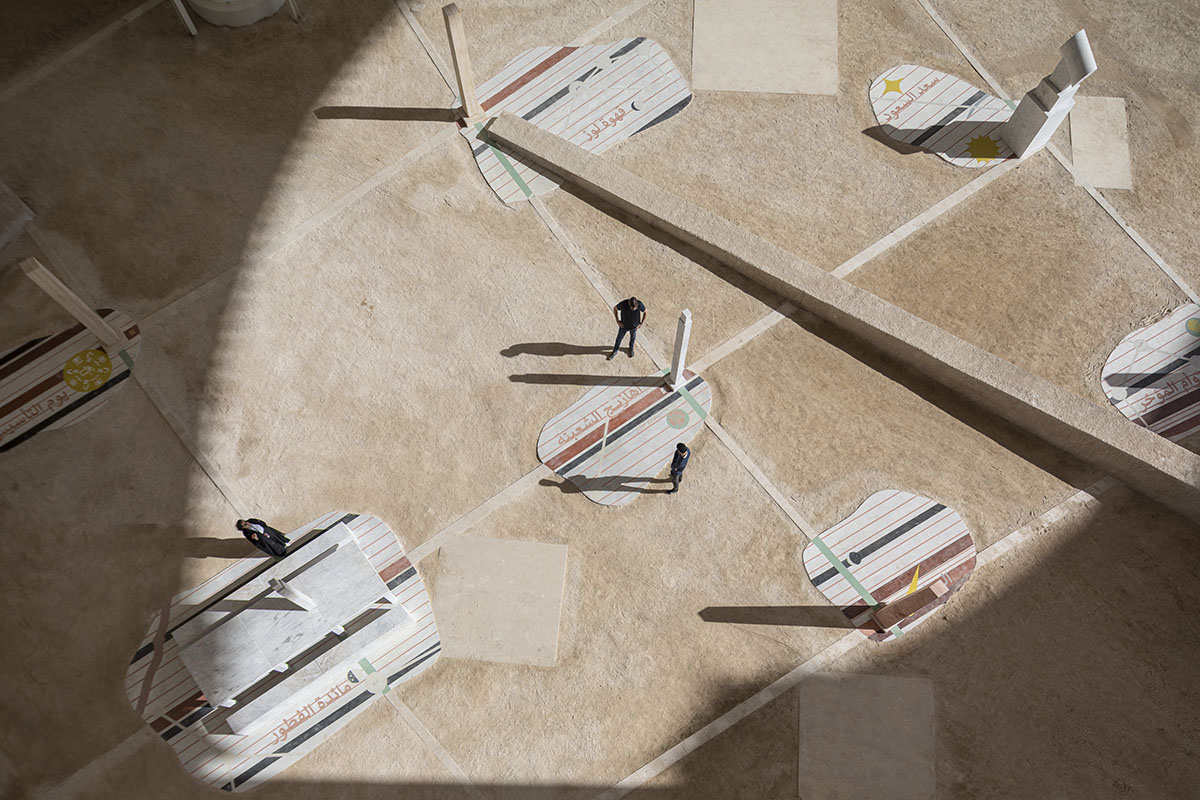Submitted by WA Contents
"Islamic Arts Biennale is a platform to express our identities" says Artistic Director Sumayya Vally
Saudi Arabia Architecture News - Apr 12, 2023 - 09:39 2939 views

"Islamic Arts Biennale is a platform to express our identities and creative worlds," says Islamic Arts Biennale artistic director Sumayya Vally - who is the founder of Johannesburg-based architecture practice Counterspace.
In this exclusive interview with World Architecture Community, Vally explains how Saudi Arabia's first Islamic Arts Biennale unfolds the philosophies of Islam and how the potantial ways of being can offer creative worlds through the art.
According to Vally, Islamic Arts Biennale are different in many ways and presents "a different definition of Islamic Art".
"A historic moment for the canon of Islamic Art"
South African architect Sumayya Vally said that "this is a historic moment for the canon of Islamic Art."
"We have not yet had a moment or a platform to express our identities on a platform, which thinks through the potential that ways of being offer creative worlds," she told World Architecture Community.
"The Islamic Arts Biennale presents a different definition of Islamic Art - one that is resonant with our practices and experiences of being of the Muslim world. It goes to the root of philosophies and practices and draws on the knowledge, wisdom and experience of rituals in the faith - to deepen our appreciation of our daily practices and to transfer their meaning to audiences in diverse ways," said explained.
"Some works are tied to rituals of the faith, and the experience, the philosophy and meaning behind them, others to the human spiritual experiences and cultural life of the Islamic world."
"These are related to food, to sound, to tradition, to the customs of generosity and hospitality, to sharing - the infrastructures of gathering and of community," she added.
"The philosophies of the Islamic faith offer the potential to think about the future differently," Vally continued.
"Beyond the stylistic traditions that have been called Islamic arts, and to show how the philosophies of Islam and how the life of being a Muslim can inspire creativity and creative thinking."

Image © Marco Cappelletti, courtesy of OMA
The first ever Islamic Arts Biennale is taking place from January 23 to May 23 in the Western Hajj Terminal designed by Skidmore, Owings & Merrill in 1981 in Jeddah, Saudi Arabia.
While OMA worked the scenography for the inaugural edition of the Islamic Arts Biennale 2023 with "a desert-like landscape", Sumayya Vally served as the Artistic Director.
Her role included from the development of Biennale's theme, concept, narrative, atmosphere, experience and theme identity, curation of contemporary commissions to the direction and narrative of the spaces.
Vally worked alongside a distinguished curatorial team, which includes Dr Saad Alrashed, leading Saudi scholar and archaeologist, Dr Omniya Abdel Barr, conservation architect and Barakat Trust Fellow at the Victoria and Albert Museum, and Dr Julian Raby, Director Emeritus of the National Museum of Asian Art, Smithsonian Institution, Washington DC.
The biennale was spearheaded by the Diriyah Biennale Foundation, a catalyst for global dialogue between art communities within Saudi Arabia and the rest of the world.

Sumayya Vally. Photography © Marilyn Clark
"We reflect on how rituals are carried in the construction of home and belonging"
Vally chose Awwal Bait (First House) as the theme of biennale, which invites visitors "contemplation of belonging".
She commissioned many artists and architects from Saudi Arabia and other countries in the Middle East and Northern Africa as well as the UK and South Africa.
"I have been excited by the opportunity to create a temporary home, an entirely new physical setting in this context of the Muslim pilgrim’s journey, in which to invite artists and audiences to reflect on ritual, the sacred, the personal and the communal," she told WAC.
"Awwal Bait (First House) is a term of reverence which is given to the Kaaba in Makkah, the centre of our rituals," Vally explained.
"Through this evocation, we reflect on how we construct first home or first house - internally and externally. We reflect on the ingredients of internal spirituality and of community."
According to the architect, "the theme looks to how the source has travelled, as we reflect on the migration of the first muslims from the Awwal Bait to the city of Medinah."
"We reflect on how rituals are carried in the construction of home and belonging. Many contemporary migrations in our world are synonymous with loss and displacement," she continued.
Prototype of a Reassembled Mosque (Hijrah section) by Yasmeen Lari, courtesy of Diriyah Biennale Foundation
"Artists explore contemporary interpretations of instruments of home"
"In many of these scenarios, rituals become constructions of belonging - bridges between here and elsewhere. The Islamic Arts Biennale draws on these themes, presenting experiences that surround these expressions and forms of belonging - reflecting on the role of rituals in creating connections and constructing belonging."
"These fragments inspire, narrate and render visible wisdoms, imaginations and futures of “home” and spiritual placemaking; from the scale of the body to the scale of the celestial."
"Artists explore these themes through contemporary interpretations of instruments of home," she added.
Pakistani architect Yasmeen Lari, Jeddah-based practice Studio Bound and Kuwait-based Civil Architecture, South African artist Igshaan Adams, Ziad Jamaleddine - Assistant Professor at Columbia GSAPP and co-founder and partner of L.E.FT Architects are among the participating artists and architects.

Image © Marco Cappelletti, courtesy of OMA
According to the architect, the experiences created in the biennale spaces include atmospheric and communal experiences, including oral, aural and ritual practices.
Vally emphasized that the selection of the theme of the biennale is based on the roots, rituals and practices of belonging in Islamic Art - our constructions of first house/first home.
"It was also important to collapse the distinction between contemporary and historic," Vally said.
"By placing these in conversation - we give contemporary practices a home by giving them a lineage, and we give historic objects a home by giving them a relevance and future."
"I wanted to reflect on the significance of celebrating this diversity of cultural identities in bringing forth different worlds," the architect continued.
"In my artistic direction of the scenography, I wanted to create a set of sensory atmospheres."

Image © Marco Cappelletti, courtesy of OMA
Biennale presents two main sections: Qiblah (Sacred Direction) and Hijrah (Migration)
The first section, called Qiblah, presents "newly built galleries" that introduce "a choreographed trajectory", while these spaces allow visitors "a progressive sense of orientation as they move from one room to another."
Vally said that "Qiblah is the sacred direction we face towards in prayer, which reflects on the symbolic gathering created through our rituals."
"In this theme, we move across atmospheres from darkness into an explosion of light, evoking the infinity of this symbolic gathering. We also build up in the scale of the gathering."
"We start with the scale of the sound of the call to prayer at vibrational frequency of the atom, called from the farthest corners of the world, the limbs in ablution, the body in prayer, gathering in prayer.
"And the Kaaba - this central moment that we gather towards - symbolically gathering us with those past, present and future who face this direction in prayer," she said.
Hijrah makes up the second section of the biennale, which includes the works situated outdoor, underneath the tented canopy of the Hajj terminal. "The site itself is a symbol of migration - it is a functioning gateway to pilgrimage," according to the architect.
"When I first visited the site as we were looking for sites for the biennale, I was flooded with memories of being there as a pilgrim - of seeing people gathering from around the world in this site: seeing food from around the world, hearing sounds and accents from different places, and experiencing people leading each other in prayer."
"It truly felt like a city made up of the entire world underneath the tented canopy designed by SOM. I wanted to honour this energy in the outdoor spaces," she added.

Image © Marco Cappelletti, courtesy of OMA
"Existing definitions of Islamic art often focus on style, tradition, geography, pattern, and geometry," Vally explained.
"The ambition of the Biennale is to build on and challenge these criteria, expanding on the existing canon of Islamic art, and to question the narrative, museological, and artistic practices of this time."
"Islamic artworks may have surface similarities, but what really unites them is inherent in how they are made, used, and understood," she continued.
Exhibition "brings together a range of experiences and forms of worship"
While commissioning the artworks, Vally aimed to create an exhibition that brings together a range of experiences and forms of worship.
"I have attempted to imagine what an exhibition can be when conceived as a series of experiences and forms of worship," she said.
"Considering both the material and immaterial dimensions of the artworks and artifacts throughout the biennale delivers an appreciation of the knowledge we inherit—available wisdom for our daily lives."
Regarding the outdoor scenography, she conceived the selected outdoor artworks "as landscapes and spaces for gathering and community - invitations for activations."
Vally emphasized that "these methods - that of the atmospheric, the ritual and the communal - come with logics that are different from white cube scenography - and propose spaces that encourage emotion, touch, talk, interaction and gathering."

Image © Marco Cappelletti, courtesy of OMA
Sumayya Vally also stresses the importance of Saudi Arabia, which has been criticized internationally in many ways, for this art biennale and adds: "As the source of Islam, The Kingdom of Saudi Arabia is the custodian of the two holy mosques and the sacred landscapes surrounding them - a spiritual home for Muslims from across the world and invites contemplation of belonging."
"Awwal Bait (First House) refers to the reverence and symbolic unity evoked by the Ka‘ba in Makkah, and underscores the importance of the geographic location of this biennale."
"At the same time, it reflects on the construction of 'home' through our spiritual and cultural rituals in Islam; acts which both unite us and celebrate our diversity and cultural hybridity."
"In these rituals, we refer to our Awwal Bait, our shared spiritual home," she added.
"However diverse, and wherever we are; Awwal Bait - Makkah - and Madinah, the city Prophet Muhammad PBUH migrated to - are present in our rituals of worship."
"It is present through invisible lines of direction, reverence through study and memory; or through our daily rituals and forms of cultural life."
"It is held in the hearts of all muslims. This shared source manifests unity in core philosophies of Islam, an understanding that we are connected to each other through our shared rituals, as we physically and metaphorically turn toward our shared home," the architect explained.

Under the same sun by Civil Architecture (Hijrah section). Image © Laurian Ghinitoiu
Biennale features both historical artefacts and archaeological findings
Alongside the newly-commissioned works, the biennale features a mix of works both historical artefacts and archaeological findings from the region. Each of the artists was commissioned to reflect these themes "through contemporary interpretations of the following instruments of home."
"In this section, facing inward toward the holy sites through historical artefacts and archaeological finds from the region; we reflect on our daily salaah, as it references the holy sites and directs us heavenward," Vally explained.
"It is often said that the submission in salaah is a metaphor for our lives - the salaah said for us at the end of our lives is in response to the call to prayer recited in the ear of a newborn baby."
"Focusing on these themes of salaah, we invite artists to reflect on the wisdoms of our daily meditative rituals in engendering transcendence," she continued.
Representing the biennale's second section, "Hijrah, translates as “migration," the architect added. "It references the ways in which the Islamic faith has traveled outward from its point of origin through the rest of the world, and looks at the construction of cultural belonging and sites of cultural hybridity."
Circa Now (Hijraj section) by Rund Alarabi at the Islamic Arts Biennale 2023. Image courtesy of Diriyah Biennale Foundation
"Biennale reminds of those forms and moments which spark community"
Sumayya Vally believes that visitors are reminded of "those forms and moments which spark community" accross the biennale.
Among them, she underlined that the works of these artists, Kuwaiti-Puerto Rican visual artist Alia Farid, London-based artist Lubna Chowdhary and Sudanese artist Rund Alarabi, refer to moments that create a sense of community.
"We see a reconstruction of a medieval well along the Darb Zubaidah, one of the longest pilgrim roads of the early Islamic period, in conversation with Alia Farid’s serpentine seating structure, which choreographs is the existing furniture in the Hajj Terminal."
"Lubna Chowdhary’s work reflects on communal rituals surrounding food, taking the form of an “endless” iftar table, its modular parts running some forty meters in length and embodying generosity in its multiple possible permutations."
"Over the course of the Biennale, these spaces host gatherings at which to share both food and ideas."
"They also remind us of the influence of the influx of people over time on the food of the Makkah region, and the hybrid DNA of Hijazi cuisine," she emphasized.
Endless Iftar (Hijrah section) by Lubna Chowdhary. Image courtesty of Diriyah Biennale Foundation
She also highlighted another work of Sudanese artist Rund Alarabi at the biennale. According to Vally, Alarabi's "series of large-scale photocollages brings together similar strands of her “homes”, Jeddah and Khartoum, Sudan, reflecting on the cosmopolitanism that the pilgrimage brought to Jeddah."
"These and other works remind us of the importance of the rituals and sites associated with Hajj as nexuses in facilitating exchange," she added.
"As places to gather, share, meet, and differ they are engines of cultural production, hybridity and, by extension, empathy and understanding. Through being with each other we access knowledge and find our home," Vally concluded.
The first Islamic Arts Biennale is taking place from January 23 to May 23 in the Western Hajj Terminal designed by Skidmore, Owings & Merrill in 1981 in Jeddah, Saudi Arabia. The Western Hajj Terminal was the recipient of the 1983 Aga Khan Award for Architecture.
Top image in the article: Sumayya Vally. Photography © Marilyn Clark.
> via Counterspace
